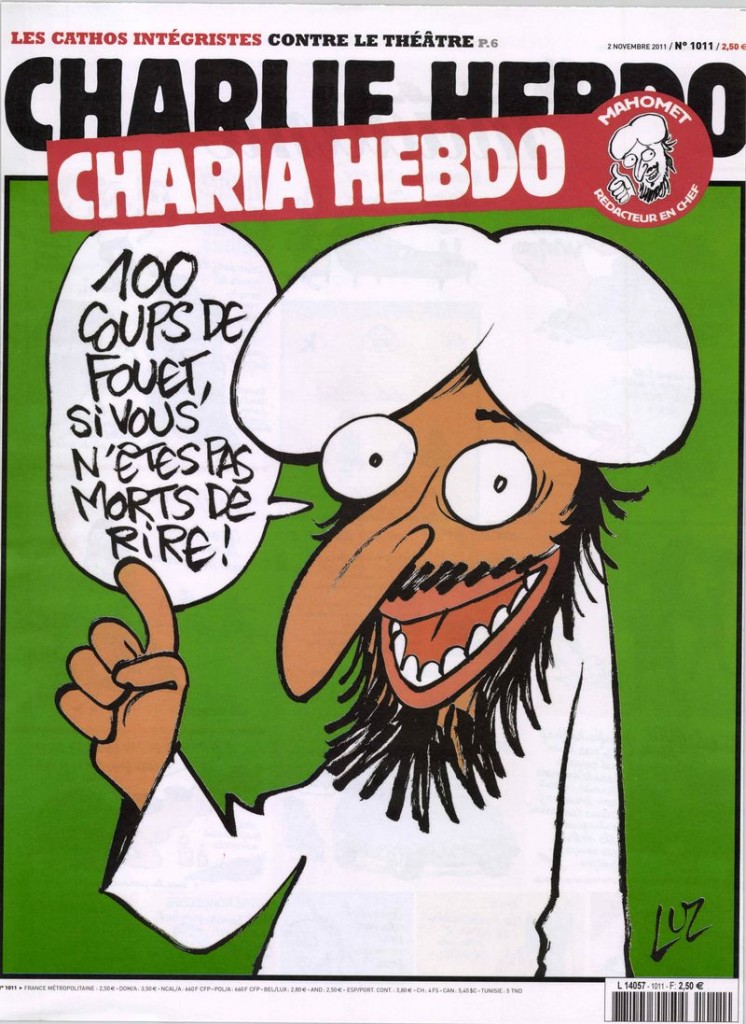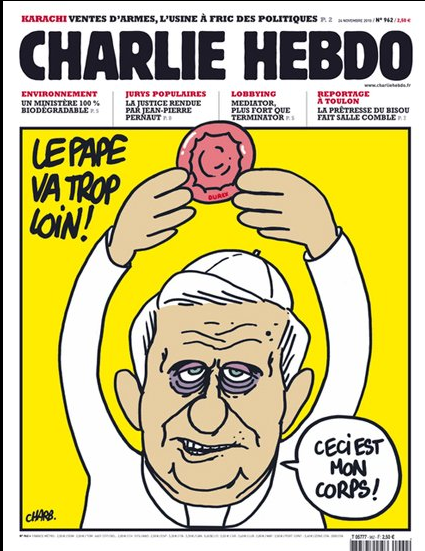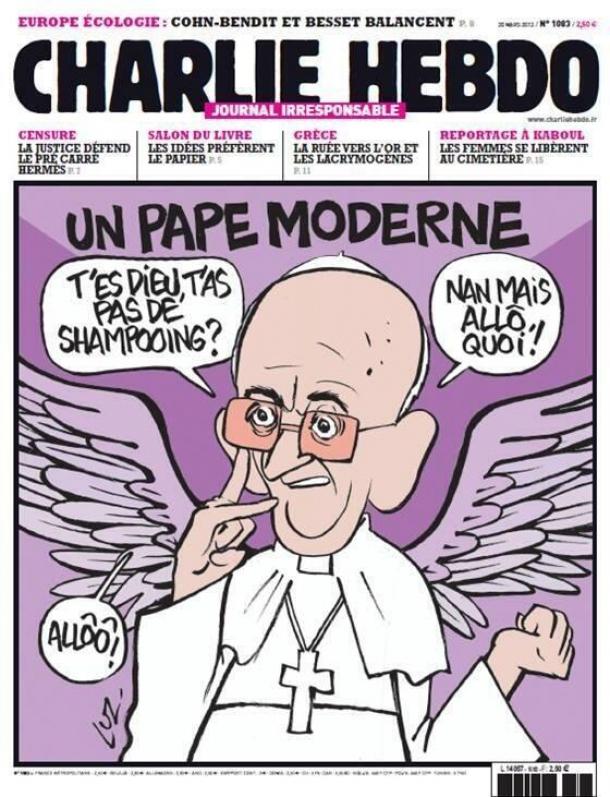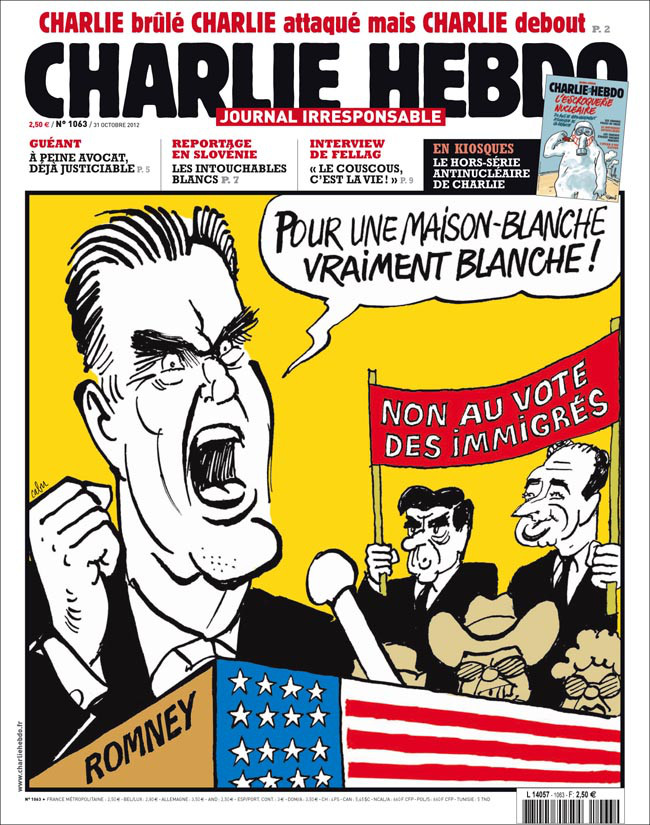This week, the New Times republishes covers from Charlie Hebdo, a French satirical magazine that was the target of a massacre by Islamic terrorists. Editor-in-chief Larry Dietrich explains why.
Maybe it’s impossible to find rational motives in something as irrational as an attack on cartoonists. But this is certain: If the goal of the gunmen who killed 12 people in an attack on the offices of Charlie Hebdo was to silence the satirical magazine and intimidate journalists, they failed spectacularly.
In the icy cold and wind of Clinton Square on Saturday night, reporters and editors – and some people with no connection to the media – gathered at a candlelight vigil for the dead in Paris. It was a night to stay warm at home; these people didn’t, because they thought it was important to do something to express their solidarity with the slain journalists.
The vigil in Syracuse was inspired by one in San Antonio. And these two were just a taste of the marches, vigils, rallies, statements, editorial cartoons and commentary from across the globe in support of freedom of expression. Millions rallied Sunday in France. It’s not a cause that usually inspires such anger, sorrow and passion.
And it’s about the cause, not about Charlie Hebdo. Two weeks ago, you would have been hard-pressed to find people in Central New York who could tell you what Charlie Hebdo was or why it might be the target of murderers. Even in the aftermath, many media outlets – the New York Times, the Associated Press, PBS – chose not to republish the material that brought the killers to Rue Nicolas-Appert; if they were the sources of your news, you still might not know.

AFP PHOTO / HO /CHARLIE HEBDO
The New Times will display some of the content that led the Islamic attackers to execute their death sentences. We’ll give you some of the flavor of the magazine to give you context: It wasn’t just Muslims that Charlie Hebdo offended. And you’ll find some of the powerful images created by the world’s cartoonists in reaction to the killings.
The media outlets that have chosen not to republish the cartoons say they don’t fear more reprisals. Rather, they say, the materials would offend some of their readers and viewers.
That’s a valid concern, one that we at the New Times weighed, too. We don’t doubt that some of our readers will be offended. Frankly, there were cartoons that we thought were beyond the bounds of what we would consider republishing; it’s an understatement to say Charlie Hebdo pushed the envelope of good taste.
But isn’t that always the way it is? It’s not Citizen Kane that calls us to the ramparts to defend freedom of expression; it’s The Interview. It’s not the Washington Post and Ben Bradlee for which we stand in defense of press freedom; it’s Hustler and Larry Flynt. It’s not the eloquence of Mario Cuomo that calls us to protect freedom of speech; it’s Nazis in Skokie, Ill., and the Westboro Baptist Church.
We apologize to those who may be offended by the images that follow. We don’t mean to offend, but we think it’s important to air the material at the heart of this tragedy.
Charlie Hebdo
Charlie Hebdo (hebdo is short for hebdomadaire, which means weekly) was born in 1970 from the ashes of another satirical weekly, L’Hebdo Hara-Kiri.

Muhammad says: “One hundred lashes if you don’t die of laughter.”
On Nov. 9, 1970, the iconic French leader and former president and prime minister Charles de Gaulle died at his home in Colombey-les-Deux-Eglises. Eight days earlier, a fire at a nightclub killed 146 people. You can imagine which event dominated the news columns. So L’Hebdo Hara-Kiri commented on the apparent relative value of these lives with the headline: “Tragic ball at Colombey, one dead.”
It got the weekly banned. They could do that in France.

In response to the ban, Charlie Hebdo was born. The “Charlie” was said to be a reference to the Peanuts cartoon and to Charlie Brown. It was also understood to be a joking reference to Charles de Gaulle.
The new weekly was published until 1981, then closed. It was reborn in 1992. Wikipedia describes it as “a French satirical weekly newspaper, featuring cartoons, reports, polemics and jokes. Irreverent and stridently non-conformist in tone.” Indeed.
It’s published on Wednesdays, and it has a circulation of about 45,000 (which happens to be similar to the New Times).
In 2005, the Danish newspaper Jyllands-Posten solicited cartoons depicting the Prophet Muhammad. The point, its editors said, was to see if Danish cartoonists — knowing the likely displeasure of Muslims, and extremists — were afraid to create such cartoons.
Editor Flemming Rose wrote that the demand by Muslims of “special consideration of their own religious feelings … is incompatible with contemporary democracy and freedom of speech, where one must be ready to put up with insults, mockery and ridicule.”
On Sept. 30, 2005, Jyllands-Posten published the cartoons it received.
All hell broke loose.

It outraged Muslims. Some newspaper vendors refused to sell it. There were lawsuits. There were death threats. Others rallied to defend the right of the press to print what it saw fit. About 200 people died in demonstrations around the world against the cartoons, the New York Times reported. Embassies were attacked. Politicians lost their jobs based on the position they held on the controversy.
The cartoons were republished, both in Islamic and non-Islamic countries. On Feb. 9, 2006, Charlie Hebdo reprinted them. On the cover was Muhammad under the headline “Muhammad overwhelmed by fundamentalists.” The prophet, hands over his face, says, “It’s hard to be loved by jerks.”
Muhammad has since appeared on more Charlie Hebdo covers, as have the pope, Jews and people representing other faiths. The weekly does not target only Muslims for its satire.


Jesus says: “I am a celebrity. Get me out of here!”
And that’s reflected in some of the reaction to the killings. Bill Donohue, president of the Catholic League, condemned the violence, but added in his statement:
“Those who work at this newspaper have a long and disgusting record of going way beyond the mere lampooning of figures, and this is especially true of their depictions of religious figures. For example, they have shown nuns masturbating and popes wearing condoms. They have also shown Muhammad in pornographic poses. … Stephane Charbonnier, the paper’s publisher, was killed today in the slaughter. It is too bad that he didn’t understand the role he played in his tragic death. In 2012, when asked why he insults Muslims, he said, ‘Muhammad isn’t sacred to me.’ Had he not been so narcissistic, he may still be alive.”

Pope says: “This is my body.”

Pope says:
“You’re God and you didn’t shampoo? Hello? A girl without shampoo is like a girl with no hair!’
Donohue’s remarks were widely criticized. But given Charlie Hebdo’s commentary about such things as the Roman Catholic Church’s child abuse scandal and its doctrine on such issues as contraception and homosexuality, they couldn’t have been a surprise.
The main focus of Charlie Hebdo is politics, not religion. Usually, it skewers French politicians and other Europeans, of course. But U.S. politics sometimes falls into its crosshairs.
In this cover, Mitt Romney speaks. Behind him is a banner that reads, “No to votes for immigrants.” And Romney says, “For a truly white White House.”

There will always be something akin to censorship within journalism. That’s what editors do: They choose what will be covered, and how; they’re gatekeepers for the flow of information. For example, the New Times chose not to print some images from Charlie Hebdo that we felt crossed the line, even for this look at material published by the French weekly.
But those are our choices, not choices imposed on us by a government or a bunch of thugs.

Muslim says: “But, I am the Prophet!”
Terrorist says: “Shut your trap, infidel!”
Perhaps it’s because journalists already make choices like this that the reaction to the slaughter in Paris has included suggestions that Charlie Hebdo should have been self-policing, that its editors should have made sure that what it printed wouldn’t bring down on the staff the sort of reaction we saw last week.
We reject that. There may be limits on the expression of free speech — child pornography must be stopped and prosecuted, for example — but the notion that intimidation should curtail commentary, even through self-censorship, is wrong. If the cartoonists had chosen to pull their punches out of fear of what extremists might do, the extremists would have won.
And that’s unacceptable. It makes a mockery of freedom of expression, which is what gives journalism much of its power and importance.
The Syracuse New Times isn’t just a beneficiary of that freedom. We believe in it.
Je suis Charlie.
Nous sommes tous Charlie. (We are all Charlie.)









